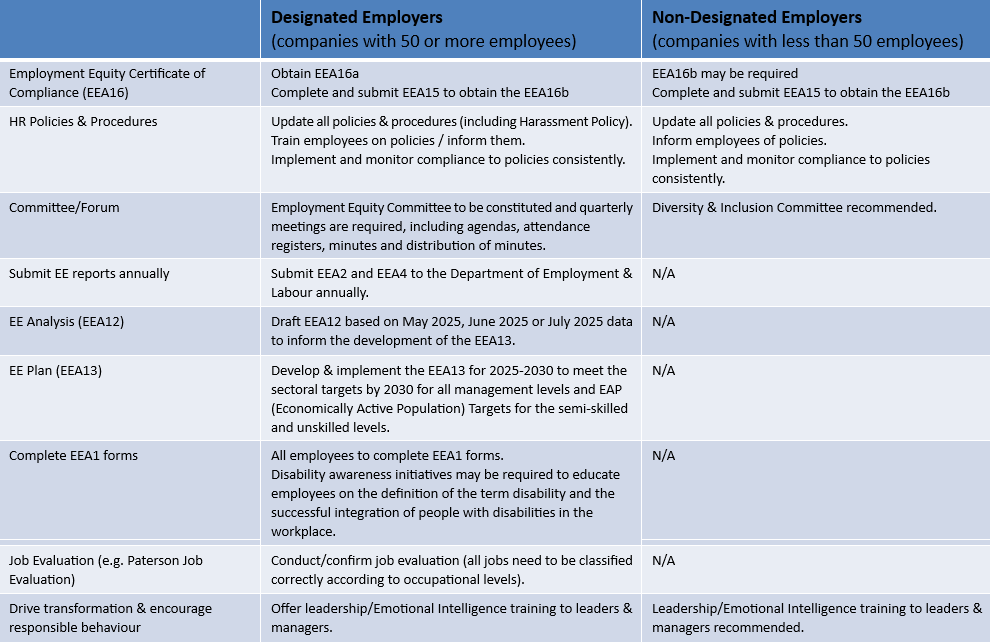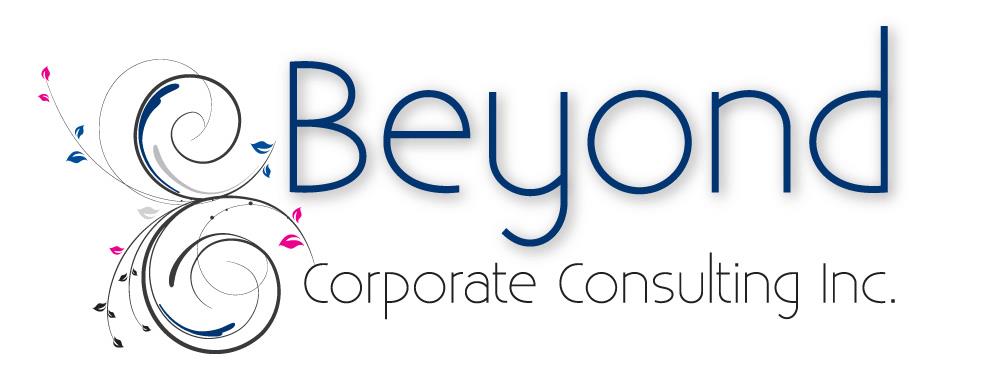Employment Equity
The Employment Equity Act, Act 55 of 1998, was established to address unfair discrimination and ensure equality in the work place. Major changes have recently taken place with regards to the Employment Equity Act and organisations need to be shift the focus to a broader application of transformation to ensure full compliance.
The aim of the Employment Equity Act is:
- To promote equal opportunities and fair treatment to all in the workplace by eliminating unfair discrimination; and
- To implement Affirmative Action (AA) measures to redress the disadvantages in employment experienced in the past by members from designated groups.
Enforcement as per the EE Act is streamlined towards “larger employers” with a greater capacity to drive transformation. Employment Equity compliance is no longer only measured by meeting specific EE targets/goals. The behaviour of your employees, leadership commitment and corporate culture will also impact on your compliance as unwanted behaviour or unfair discrimination may lead to adverse findings at the CCMA or Labour Court – which means that you will not be able to obtain your Certificate of Compliance (EEA16) even if you meet the required targets/do everything else in the right manner.
The main changes to the Employment Equity [EE] (as per the 2024 and 2025 updates are as follows):
- Definition of Designated Employer:
- A Designated Employer is a company with 50 or more employees (as per the workforce profile of 31st August every year).
- In simple terms, a Designated Employer is a company that needs to submit EE reports, develop an EE Plan for 2025-2030 and meet specific targets aimed at transformation/implementing Affirmative Action.
- The annual turnovers that were considered in the past for the different sectors are no longer applicable. Companies with less than 50 active employees are thus NOT considered as Designated Employers (regardless of the annual turnover). This reform significantly lightens the burden on small businesses (with less than 50 employees, regardless of high turnover) that are no longer subject to Affirmative Action duties, EE reporting or EE Plan requirements.
- Sectoral Targets have been published and need to be met by 2030 (even if a company becomes designated between 2025 and 2030). There are different targets for different Economic sectors. Please refer to EEA17 for a list of the sectors with the description of the sub-sectors.
- EE Certificates of Compliance is required for all Designated Employers (EEA16a) and may also be required for non-Designated Employers. The EE Certificate of Compliance for a non-Designated Employer is referred to as EEA16b.
-
- This Certificate of Compliance is a statutory document in South Africa, issued in terms of the Employment Equity Act, no. 55 of 1998, as amended for all non-Designated Employers (i.e. companies with less than 50 employees as on 30th August each year).
- It certifies that a non-Designated Employer is compliant with the provisions of the Employment Equity Act.
- It has become more important for employers who wish to do business with the State or submit tenders.
- Who needs to obtain the EEA16b:
- When responding to/applying for State contracts, tenders or licences that require Employment Equity compliance.
- When required by a public or private sector partner (e.g. in joint ventures or procurement chains).
- When needing to demonstrate compliance during audits, inspections or B-BBEE verification purposes.
- The following 7 justifiable reasons may be used to explain if you are unable to meet the sectoral targets (in which case you will need comprehensive and updated HR records in place):
- Insufficient recruitment opportunities
- Insufficient promotion opportunities
- Insufficient target individuals from the designated groups with the relevant qualification, skills and experience.
- CCMA awards/Court order
- Transfer of business
- Mergers/Acquisitions
- Impact on business economic circumstances
- Criteria to be met for the EEA16a (Certificate of Compliance for Designated Employers):
- Meet Targets (or motivate according to justifiable reasons)
- No adverse findings against Employer for preceding 12 months on unfair discrimination by the CCMA/Labour Court
- Paying according to National Minimum Wage (NMW)
- EE Reports (EEA2 and EEA4) annually to the Department of Employment & Labour. The reporting season opens around 1st September and closes on the 15th January of the following year. Beyond Consulting can assist with the submission of your EE reports between 1st September and 15th December annually.
- Criteria to be met for the EEA16b (Certificate of Compliance for non-Designated Employers):
- No adverse findings against Employer for preceding 12 months on unfair discrimination by the CCMA/Labour Court
- Paying according to National Minimum Wage (NMW)
- Submit EEA15 annually.
These resources may be of interest to you:
-
- Sectoral Target Regulations – see the specific sector targets for each Sector
- New (2025) EE forms:
- EEA1 – Self declaration by all employees to be completed by all employees.
- EEA2 – Template for EE Report to be submitted to the Department of Employment & Labour annually.
- EEA4 – Template for Income Differential report to be submitted to the Department of Employment & Labour annually.
- EEA12 – Template for EE Analysis.
- EEA13 – Template for EE Plan.
- EEA17 – Description of the Sectors.
- CEE Report – 25th CEE Annual Report (2024/2025)
What do you need to do next to ensure compliance:
- Determine whether the organisation is a Designated or non-Designated Employer.
- Herewith a checklist for easy reference/action.

Contact us for assistance with Employment Equity compliance – info@beyondconsulting.co.za
We offer comprehensive EE services (for Designated and non-Designated Employers), including setting up of EE/Diversity and Transformation Committees, drafting EE forms, consulting with committees and executive teams, submitting EE reports, offering EE workshops/training, drafting/updating Policies & Procedures, Paterson Job Evaluation and so much more.
